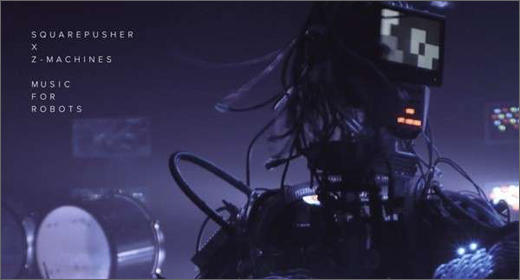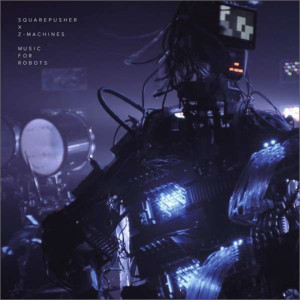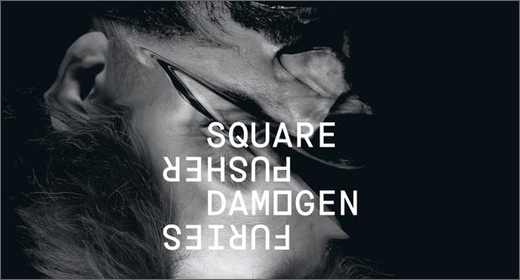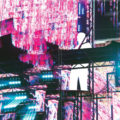“To make music using instrument-playing robots fascinates me. People have often assumed that for music to be emotionally powerful it has to come directly from a human hand, whereas I disagree with that, and enjoy proving these people wrong. This project is an excellent way of exploring that area more.”
So began the promotional video for Squarepusher‘s collaboration with the Z-Machines that created Music For Robots, Tom Jenkinson’s pioneering effort to try to make robots write emotional music. It seems like a incredibly ambitious idea, and surely if one musician has to be chosen in order to prove that robots have feelings it should be one of the most engaging IDM producers from Warp’s rooster, right?
As it turns out, the answer is no so easy to pinpoint. Jenkinson’s sound relies on a combination of well-thought out electronic compositions and an elegant and virtuoso handling of the bass guitar. Jenkinson’s compositions, however, unlike Warp peer Aphex Twin, tended to avoid emotionally rich tones in order to favor a complex rhythms and experiments in bass. There’s much to choose from Jenkinson’s discography. From the jazzy vibes of Music Is Rotten One Note to the musique concrete influenced Do You Know Squarepusher, it seems Jenkinson lives by the IDM credo of never staying in one place for far too long. Indeed, heterogeneity is one of the man’s defining characteristics. In a telling 2011 interview, the man himself would declare:
“I started getting the impression that my music was beginning to be seen as an academic effort and was increasingly appropriated by musical academia. That was a compliment, and it reflected my commitment to make what, at least at the time, I felt were bold experimental moves in electronic music. But at the same time I felt that it was a sign of me entering my own zone of scholasticism, of academic self-referentiality. Basically I was beginning to stare up my own ass. Plus there was again the danger of preaching only to the converted. So I wanted to shake things up and make music in a more spontaneous, almost flippant way, and less like I was in a laboratory.”
The reason Squarepusher’s take on “bold experimental moves in electronic music” started to be seen as an “academic effort” is because much of Squarepusher’s discography can be described as being rigorous exercises in experimental music. The man’s calculated approach can be easily appreciated in the widely known “My Red Hot Car.” It sounds less like a song and more like a careful analysis of 2 step influences. Jenkinson’s project is one of careful deconstruction—in the vulgar, bastardized sense—of structures imposed by genre conventions. A jazz influence can be heard even in the most distant metallic sounds. The spirit of calculated play becomes much more present in Squarepusher’s incursions on the bass guitar, an instrument that he clearly holds very close to his heart.
So why choose an one of the finest IDM’s academics, a jazz-head, to make robots play as if they had feelings? The question remains unanswered all along the EP. Squarepusher’s main talent for improvisation doesn’t deliver in the way the man’s gotten us used to. In a way, this EP is a lost opportunity, given how the Z-Robots are employed as guitarists and drummers on steroids, which is to say: the robots are technically better at playing fast, but are not quite there when the time to evoke feelings comes. Aesthetically, Squarepusher’s robots make exactly what you think robots with 78 fingers will play, at times, like in the EP’s opener, it seems like Jenkinson fell asleep whilst programming. As preambles go, “Remote Amber” is a forgettable piece made of incoherent parts that could easily be confused by a parody of what drunk jazz players sound like. “Sad Robot Goes Funny” doesn’t fare much better, as it mostly showcases the robots expert fingers and warped, disjointed speeds, instead of the so-called feeling Jenkinson was supposed to bring to the table.
Things fare much better with the last two tracks of the EP. Though “Dissolver” could be easily mistaken for a jazzy parody of a Dragonforce song, at least it delivers on the promise of emotionally engaging music made by robots, but just barely. For a man with a taste for analyzing structures and playing with the song’s components, it is extremely disappointing that one of the tracks the stands out the most is also the most conventional. However, it is “You Endless” that is the most classically “emotionally engaging.” The guitar begins to sound like a guitar played by a human and the superiority of the robot’s speed is exchanged for a more human, mournful tone.
The issues with Music For Robots stem from the fact that the Z-Machines were paired with a human that desperately wants to be a machine. Jenkinson’s career could be summed up with the world academic yes, but his music’s coldness is much more indebted to patterns than anything else. This, ladies and gentlemen, is an artist that wants to be a robot and these are robots that want to sound human. It is safe to say nobody got what they wanted. Not only did Jenkinson had to push away his deconstructing tendencies to embrace structure and therefore bring up a simulacra of feeling from the robots, but the machines themselves felt like a vehicle for what amounts to empty experimentation. Improvisation, one of the pillars of jazz, is, after all, a very human trait and so the robots attempts to make mistakes weren’t real. They were calculated and for a project that wanted to show the world how machines can make emotional music too, that counts as a failure.
Music For Robots is available on Warp.




















![Squaric :: 808 [Remixes] (Diffuse Reality) — [concise]](https://igloomag.com/wp/wp-content/uploads/2025/04/squaric-808-remixes_feat-75x75.jpg)






